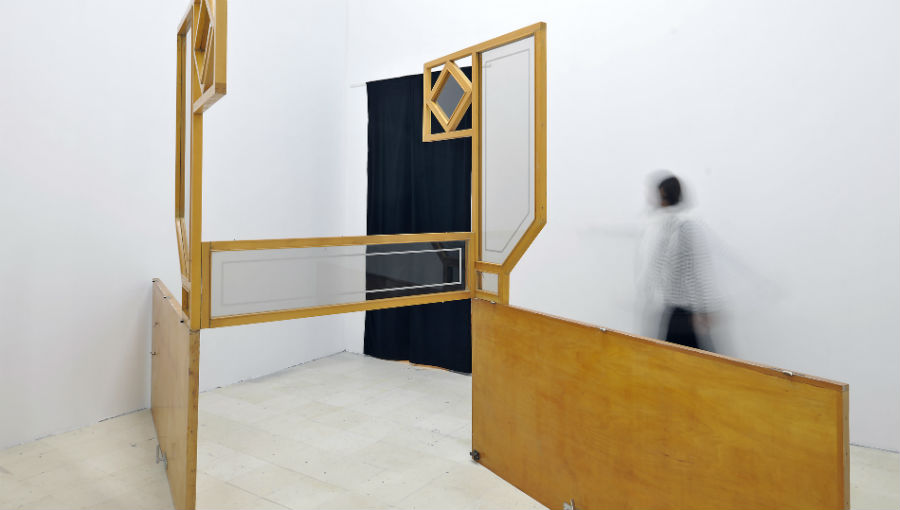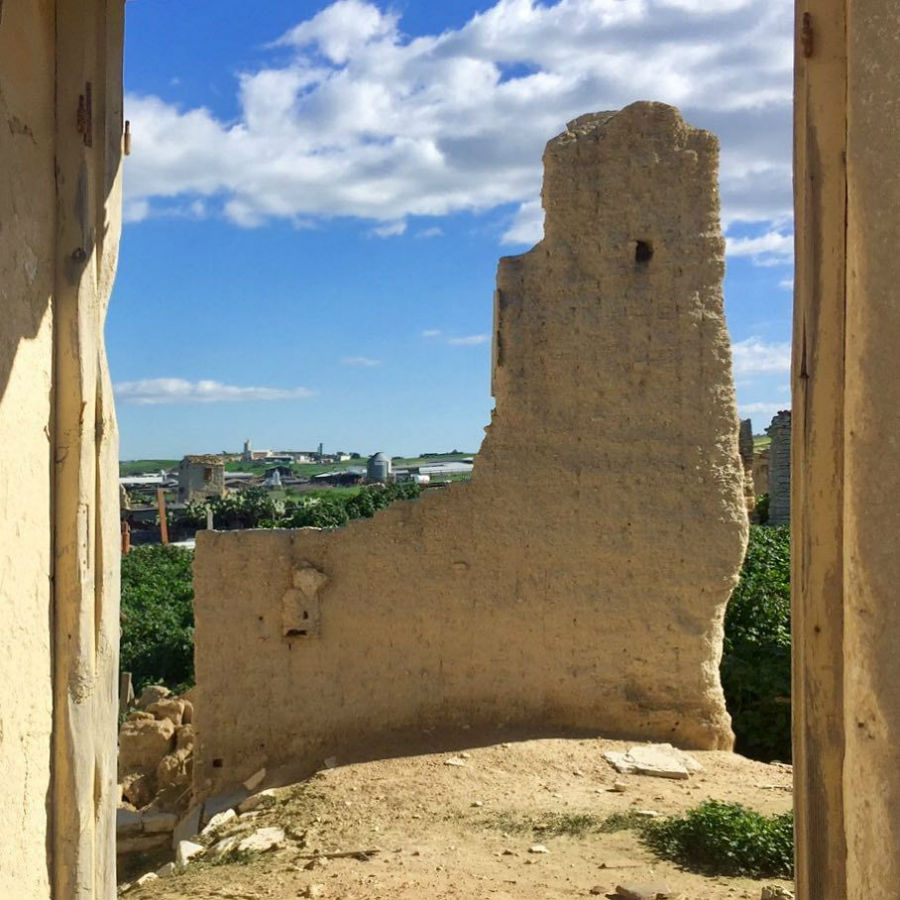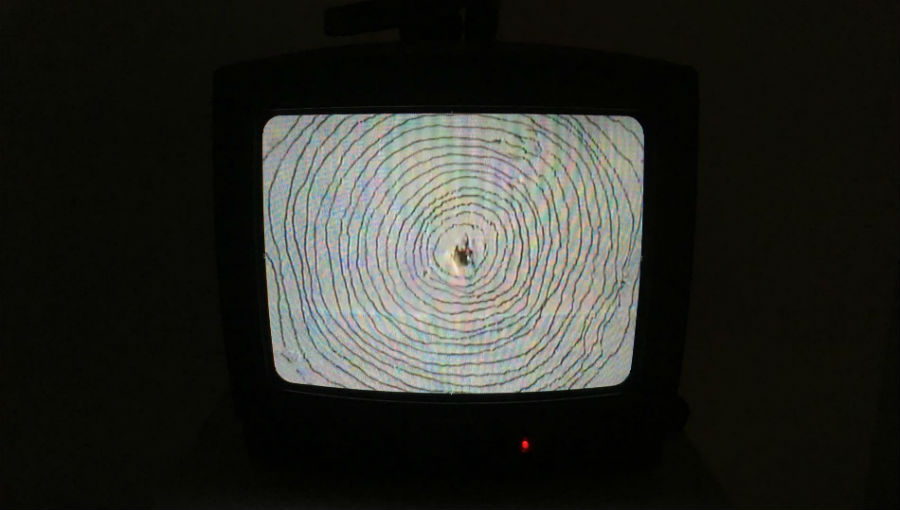What sound do empires make when they collapse? If we take a look at the history of the Eastern Mediterranean and the Balkans from the last 120 years, we could say that it sounds like screeching claws clinging on metal; the ominous rumbling of distant artillery; the clamour of civil uprising; the stretching of the rope on the gallows; and the incessant knock of a window shutter hanging miserably on an abandoned village’s last standing wall.
Text by Kiriakos Spirou.
For image credits please see end of article.

In the exhibition The Presence of Absence, or the Catastrophe Theory, presented recently at the Nicosia Municipal Art Centre (NiMAC) in Cyprus, curator Cathryn Drake revisits a haunting and much-avoided chapter in the region’s history — namely the period during the fall of the Ottoman Empire in the early 20th century and the subsequent division of its lands between the great powers of the West. Originally presented in 2016 as a group exhibition at Izolyatsia in Kiev, Ukraine with three artists from Albania, Greece and Turkey, the 2018 iteration of this incisive curatorial has expanded to include seven additional artists from Greece and Cyprus, all the while intensifying its scrutiny into a subject that local artists and curators (not to mention politicians) have up to now found too painful or sensitive to touch.
In a tragic coincidence, the show closed on the day the USA, France and Britain launched a new attack on Syria, to some extent via Cyprus’s airspace. It’s a cliché we Cypriots grew up with and a condition we were taught to live with: that Cyprus has suffered a lot over the centuries and passed from one empire to the other non-stop since antiquity because of its strategic location. After some 300 years of Ottoman rule, Cyprus became a protectorate of Britain in 1878, and then a British colony in 1922. The British applied many methods for controlling the population, and to that end they used the tension between Cypriot Muslims and Christians. The divide-and-conquer trick worked so well that when the Crown granted Cyprus independence in 1960 it retained two large areas on the island which are still considered British territory. One of these bases is a military airport, from where Britain and its allies conduct operations in the Middle East.
It is necessary here to describe the conditions that defined the 2016 version of The Presence of Absence: when Drake was invited by Izolyatsia to curate an exhibition on the issue of the Ottoman Empire, one of the main restrictions was that the show should only include videos and works that could be produced locally, because Ukraine at the time was considered at war and no artworks could be imported. This led to a video-heavy exhibition with some photos and an installation created on-site by artist Petros Efstathiadis. The new exhibition at NiMAC retains that video-heavy composition, consisting mostly of video works and photographs; even the sculptural installations in the space seem to deal with passage rather than permanence, as for example in Eleni Phyla’s haunting radio piece Move So That I Can Hear (2015), where portable radios have been placed along a narrow corridor. The devices were tuned to radio stations from both the Turkish- and Greek-speaking parts of the city of Nicosia, and their frequency waves were affected by visitor movement along the corridor. In another room, the installation A Minimum of Visible World (2018) by Vicky Perikleous consists of video projections on the walls showing camera footage of an abandoned village caught up in the UN-regulated buffer zone that separates Turkish- and Greek-speaking Cypriots. In the middle of the room, miniature replicas of the eroded houses shown in the videos stand scattered on a sleek flat surface together with traditional wooden pigeonholes — a gesture that is meant to show the potential of regeneration and hope for the area but instead creates a painful reflection on the irony of borders.

The site of a former electricity plant right in the heart of Nicosia that NiMAC occupies amplifies the exhibition’s narratives like the wooden cavity of a well-preserved oud. But visitors to the exhibition were greeted by no melodious accompaniment. Instead, a cacophony of soundtracks playing from all projectors in the cavernous space at once — albeit mindfully set to a reasonable volume and wisely refraining from using additional speakers in the space — created a randomised soundscape that sounded perhaps not like an empire coming down crashing to its knees, but more like history itself collapsing. I can’t help but remembering Walter Benjamin’s much-quoted reading of Paul Klee’s Angelus Novus (1920), and the way Benjamin saw the figure in the drawing as the “angel of history” facing the future whilst the debris of the past is piling up behind its back. From the eternally looping pockets of everyday banality in Adonis Archontides’s The Phenomenal Present (2012-ongoing) to the lone musician playing in the rabble in Leonard Qylafi’s Private Show (2006) and Petros Efstathiadis’s dystopian social worker in The Last Normal Man (2016), the videos in The Presence of Absence are full of accumulated debris and abandonment. Elsewhere, Efi Savvides documents road signs from colonial-era Cyprus found inside the British military bases — bleached from the sun and surrounded by wild growth, seemingly leading nowhere (The Empire Is Perishing; the Bands Are Playing, 2017). Scattered around the exhibition, the sculptures of Savvas Christodoulides are assemblages of salvaged objects like wooden doors, balustrades, boards, brushes and metal stands. His piece Black Mountain (2017) alludes to the jagged skyline of a mountain range using broken Formica boards precariously piled on a seemingly frail metal structure; the viewer’s gaze is led upwards at about four meters high, but instead of the sky it is only met with a blinding spotlight surrounded by the darkness hovering between the artwork and the ceiling.
Much like in Cavafy’s famous poem The God Abandons Antony (1911), in The Presence of Absence empire withdraws just like Bacchus abandons Alexandria before it falls, only in our case what is left behind is industrial waste, depleted mines, mass graves and nationalism. In that sense, the exhibition is overflowing with the bitter resilience of the victims of colonialism, who are caught up in the throes of geopolitics and left to mend whatever can be mended by building a new life in the debris. The fact that the videos in the exhibition are short in duration and constantly looping only increases this feeling of futility, exemplified in Qylafi’s video of a locust trying to climb a wall (Sisyphus, 2009). In Stefanos Tsivopoulos’s LAND (2006), three refugees are seen wandering perplexed on a dry uninhabited island; in Ali Kazma’s videos School (2013) and Prison (2013) we are offered an aestheticised gaze into the institutions of nationalist indoctrination and public punishment. It is in moments like these that Drake’s intention to weave a “collective examination of landscape and memory, amnesia and nationalism, identity and resistance” is driven home. But where the American sees “examinations” we can’t help but recognise so many ways of coping with trauma and injustice in a landscape that has not been allowed to heal.
In the absence of resolution and healing, the nations that emerged from the dissolved Ottoman Empire can only reorder the remains of that violent past and accumulate new layers of history in order to make the trauma sting less. This accumulation of layers is seen in what for me is the most resonant piece in The Presence of Absence, which is Qylafi’s Nail Song (2006) — a video showing a pencil drawing concentric circles around a hole on a wall. It reminds me of oysters building their pearl around a grain of sand: in order to cope with a sharp object inside its shell and its inability to extract it, the oyster has to wrap it up and make it smooth. In another video shown near Nail Song, Qylafi shows a time-lapse of a construction site across from his home in Tirana, where in the place of a greenhouse a new apartment tower is erected (Estate, 2007). Meanwhile, a few kilometres south of Nicosia, developers are demolishing hundred-year-old beachfront estates to erect luxury apartment towers for the super-rich seeking to acquire a golden visa in Cyprus. In the distance, bombers and fighter planes take off daily from Akrotiri Military Base for reconnaissance and other operations in nearby Syria, as floating oil rigs are being constructed in Limassol Bay to extract the newfound gas in the sea between Cyprus and Egypt.

Layer after layer of contradicting realities, the pearl of postcolonial limbo keeps growing as long as exploitation is still underway. And many of its layers are the result of carefully planned and executed construction of national identity. In order to justify the border lines drawn by the West in the Balkans and the Near East, ethnic, religious and other elements had to be inflamed or even invented to segregate the populations. These of course led to racism, fear of the other and — as our very recent past has shown — in acts of ethnic cleansing and civil war. For Drake, this of course is one of the core tropes of The Presence of Absence, especially as seen in Christodoulides’s sculptures and the way Efstathiadis composes his photographs. In Christodoulides, found objects are put together to create compositions that are given an association of meaning only through their name (Epitaph, 2017; Red Mosque, 2017; Flag, 2016). Efstathiadis on the other hand plays again with found objects but more as to emphasise the construction of identity as a haphazard, imperfect and downright absurd process.
In what is another striking moment in the exhibition, a huge projection of Ali Kazma’s Taxidermist (2010) shows how a dead animal is skinned and a mould is created on which its skin is stretched to create a life-like model. Similarly, nationalist narratives in the region have been twisting a distant historical past and cultural differences for decades in order to justify political decisions; it is in this moment when we realise that our national identities in the postcolonial limbo are nothing but a pawn in the game, a skin that we were forced to wear and which sometimes feels foreign but we simply cannot shed. We are a construct, an achievement, the glory of imperialist Europe. We are the soft victims: present and absent at the same time.
Images:
